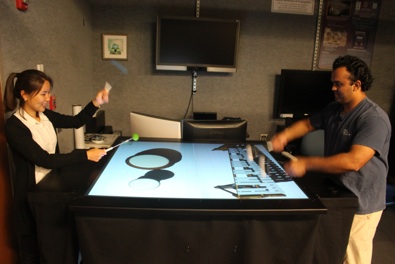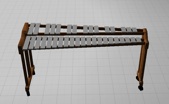Tabletop Ensemble: Touch-Enabled Virtual Percussion Instruments
We present an interactive virtual percussion instrument system, Tabletop Ensemble, that can be used by a group of collaborative users simultaneously to emulate playing music in real world while providing them with flexibility of virtual simulations. An optical multi-touch tabletop serves as the input device. A novel touch handling algorithm for such devices is presented to translate users’ interactions into percussive control signals appropriate for music playing. These signals activate the proposed sound simulation system for generating realistic user-controlled musical sounds. A fast physically-based sound synthesis technique, modal synthesis, is adopted to enable users to directly produce rich, varying musical tones, as they would with the real percussion instruments. In addition, we propose a simple coupling scheme for modulating the synthesized sounds by an accurate numerical acoustic simulator to create believable acoustic effects due to cavity in music instruments. This paradigm allows creating new virtual percussion instruments of various materials, shapes, and sizes with little overhead. We believe such an interactive, multi-modal system would offer capabilities for expressive music playing, rapid prototyping of virtual instruments, and active exploration of sound effects determined by various physical parameters in a classroom, museum, or other educational settings. Virtual xylophones and drums with various physics properties are shown in the presented system.
Publication
Zhimin Ren, Ravish Mehra, Jason Coposky(RENCI) and Ming C. Lin
Tabletop Ensemble: Touch-Enabled Virtual Percussion Instruments
Zhimin Ren, Ravish Mehra, Jason Coposky, Ming C. Lin,
ACM SIGGRAPH Symposium on Interactive 3D Graphics and Games 2012 to appear
Video
Related Links





Designing Virtual Instruments with Touch-Enabled Interfaces
Zhimin Ren, Ravish Mehra, Jason Coposky, Ming C. Lin,
ACM SIGCHI Conference on Human Factors in Computing Systems (CHI) 2012 to appear as Case Study



